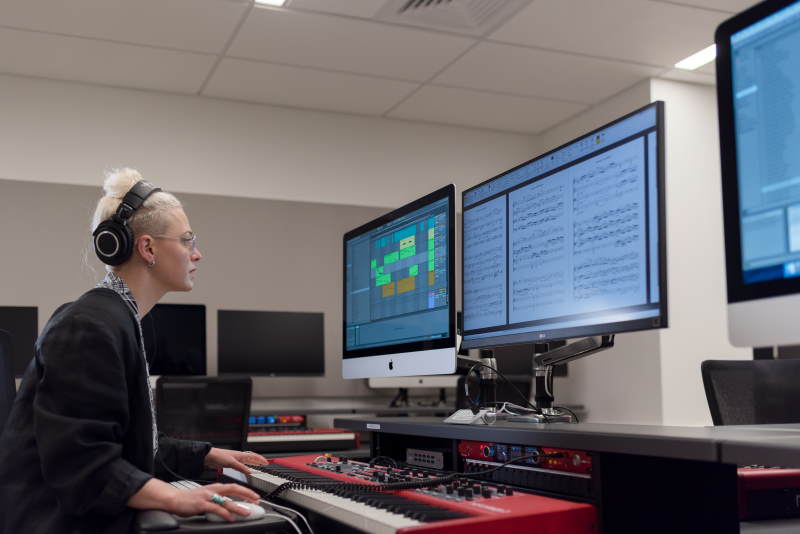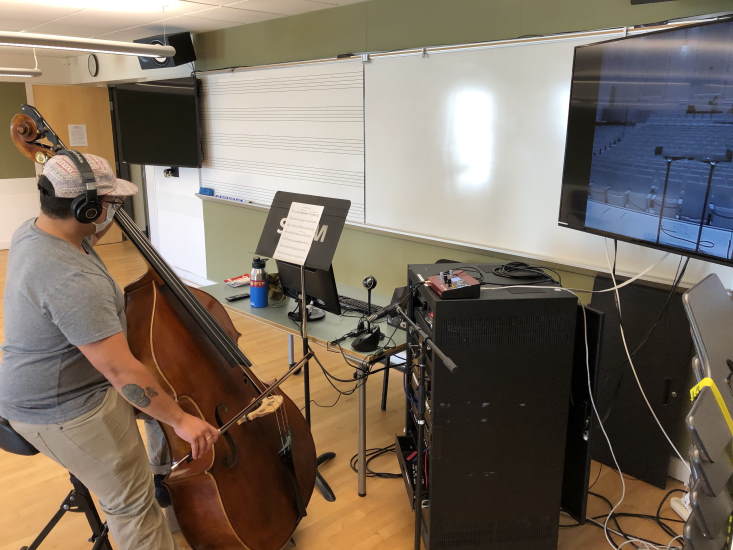Focusrite RedNet X2P Audio Interfaces Employed at the San Francisco Conservatory of Music

It sounds like the set-up for a classic musician’s joke: What’s the difference between a string player and a wind player? However, during the COVID pandemic, that’s no joke. In fact, it was the situation that confronted students and teachers at the San Francisco Conservatory of Music (SFCM), who had been unable to fully gather together to perform for much of the last year. While the school’s violinists were able to play together while wearing masks, woodwind and brass instruments and vocalists faced greater risks by performing.
Fortunately, there was a reliable solution: a Dante network installed throughout the facility, into classrooms, offices, practice rooms, and studio spaces, allowing musicians to rehearse and perform together while safely maintaining social distancing – all with Focusrite RedNet X2P 2x2 Dante audio interfaces serving as the system’s endpoints. The network was designed and installed by Emeryville, California-based Advanced Systems Group (ASG), a leading media-technology and systems-integration firm.

The project took shape last August, and RedNet X2P audio interfaces (32 in total) were the keystone components in the system. “The advantage of the RedNet X2P is that it’s an audio interface plus a headphone amp, so the musicians don't have to have monitors in the rooms,” explains Michael Groh, Sales Engineer with ASG. “They could communicate with each other, with the orchestra leader who’s down on the stage, and with the audio mixer. The Focusrite RedNet X2P is just a perfect solution for this.”
Groh worked closely with Jason O’Connell, SFCM Director of Recording Services, who has helped guide the school deeper into pro audio during the 13 years he’s worked there. These efforts have included the implementation of the Technology and Applied Composition program, which focuses on using technology to compose for video games and for mixed media – a curriculum that has attracted more students to the school’s programs. Last March, as the pandemic-driven shutdown descended on the country, he quickly realized its implications for music education. “Basically, anything to do with a singer, a woodwind player, a brass player - they can’t play in a room together during this pandemic,” says O’Connell, who studied audio at McGill University under renowned producer/engineer/educator George Massenburg.
As the school’s leadership sought ways to re-open teaching, O’Connell looked for solutions. At first they tried using standard video conferencing to connect everyone, but the sonic quality and latency were a major problem from the start. “We struggled for a couple of months with that,” he recalls. Analog tie lines were another option, but running enough copper cabling to connect even a fraction of the school’s 400-plus students dispersed across more than a dozen performance spaces was daunting. Then, it occurred to O’Connell that a Dante network would solve the connectivity challenge, and a call to Groh brought the Focusrite RedNet X2P audio interfaces into the picture. Two RedNet X2P units arrived and were set up on the school’s VLAN as a proof of concept. “We brought some musicians in and had them play together, and they were amazed at how fluidly they went from getting the microphone and headphone levels, and then all of a sudden they were having a lesson, talking about phrasing, and talking about tone,” he says. “You just can’t hear these nuances on a standard video conference. When they finished, they ended up asking to stay for a whole hour to do their entire lesson. They were just so happy to have been able to play with each other, and they were just so excited. At that point I was like, ‘Okay, this is the way that we need to move forward.’”
And they did, in time for the fall semester. With Dante as the backbone of the project and using RME TotalMix FX software for routing and mixing, the school installed 32 RedNet X2P units (acquired thought Focusrite's educational program) in various classrooms and other spaces, creating a 64-channel stereo network, with a network latency of less than five milliseconds. The system is supplemented by Audio-Technica ATH-M50x and ATH-M40x headphones and an assortment of studio-grade microphones. “Basically, we've been supporting every single ensemble rehearsal, but also lessons, including one-on-one lessons between students and instructors,” says O’Connell, who adds that RedNet features such as remote control of microphone preamps and levels further make it a perfect fit for networked application like the school. “Being able to remotely control all these boxes is super helpful for us and allows us to be much more efficient in our support of the lessons and rehearsals,” he explains. Without RedNet X2P, O’Connell declares, “Probably a third of our student body would probably be not able to be here and take classes as effectively.”
Taurin Barrera, Executive Director, Technology & Applied Composition, at SFCM, stated, “Over the past year of playing over Dante with Focusrite RedNet, all of our students have become more familiar and comfortable with essential recording studio technology such as audio interfaces, microphones, and monitors. Our students have been able to discover the fantastic possibilities enabled by state-of-the-art music technology and professional-grade recording equipment. Now that our entire campus can function as a giant, modular recording studio, I’m really looking forward to seeing what new types of network-based music projects, collaborations, and performances we can develop in the future."
Tom Menrath, Audio Team Leader at ASG, remarked, “We are proud to work with the San Francisco Conservatory of Music, a Bay Area institution. When the pandemic hit, they were quick to embrace new technology to allow them to keep up their high standards of musical education. Focusrite was a key element in our system design to help them make that happen.”
 How to resolve AdBlock issue?
How to resolve AdBlock issue?